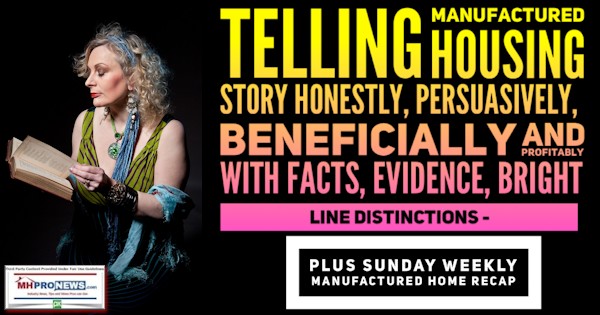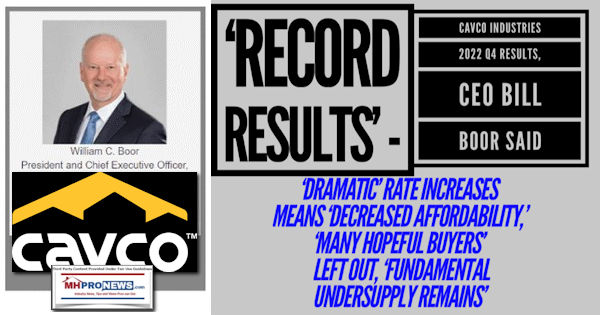
Cavco Industries (CVCO) William “Bill” Boor, CEO relates below two distinct types of ‘records’ in describing their corporate results. Both are eye opening. One is record corporate results, which this article will provide. Another is his reference to being a bit of a ‘broken record.’ Said Boor, “I feel like absolute broken record” but…and then he explains why he has to keep repeating a certain refrain. Tipping the hat to Boor on that terminology and notion, there are times that MHProNews may sound like a ‘broken record’ on several manufactured housing industry related issues too. Sorry about that, but when the facts and evidence demand that repetition, then providing the facts, evidence and common-sense analysis is what sound trade journalism demands should be provided. As with many corporate or other transcript, this is one from Cavco is not a short read. But it is laced with insights that you routinely won’t get from reading information from the Manufactured Housing Institute (MHI), much other sources that more or less act as MHI’s various mimicking mouthpieces.
As with any corporate communication, this report is positioned to put the company in the best possible light, based upon the circumstances. From a dollars and cents perspective, it is impressive in several ways.
Recall that a publicly traded firm is by law and regulation supposed to be candid in such communication. Deliberate deception by a corporate spokesperson can violate an array of federal laws and can create liability issues for those involved. Given the Cavco experience with the Securities and Exchanges Commission (SEC), which they admit has cost the firms millions of dollars annually for some time, one might think Cavco would want to limit or avoid more of that type of exposure.
Seeking Alpha is the source of the transcript and they also have an audio of the Cavco Industries (CVCO) Q$ 2022 results, from which the information below was obtained. That with their audio can be heard or accessed at this link here.
There are apparent typos that have not been changed in the below, because the meaning is largely the same. An example is “Traffic is still high and we’re still getting deposits, seeing in our [company-owned] retail as well as our independence.” That should likely be ‘independents’ not “independence,”
but to industry professionals or some savvy investors, they should grasp the intention of that remark – which implies street retailers that are not owned by Cavco Industries (CVCO).
That said, an example of an apparent typo like “single lives” was corrected below as follows: “single lives [wides].”
Highlighting below will be added by MHProNews on 5.31.2022. Highlighting should not distract the reader from digesting all of the content, but rather is intended to focus on issues that MHProNews will likely raise in the foreseeable future based on those remarks.
With that forward, here is the transcript, which will be followed by additional related and linked information and analysis.
Cavco Industries, Inc. (CVCO) CEO Bill Boor on Q4 2022 Results – Earnings Call Transcript
May 27, 2022 2:49 PM ETCavco Industries, Inc. (CVCO)
Cavco Industries, Inc. (NASDAQ:CVCO) Q4 2022 Results Conference Call May 27, 2022 1:00 PM ET
Company Participants
Mark Fusler – Director, Financial Reporting and IR
Bill Boor – President and CEO
Allison Aden – EVP and CFO
Paul Bigbee – Chief Accounting Officer
Conference Call Participants
Daniel Moore – CJS Securities
Greg Palm – Craig-Hallum
Ian Lapey – Gabelli Funds
Operator
Ladies and gentlemen, thank you for standing by. Welcome to the Fourth Quarter and Fiscal Year 2022 Cavco Industries Earnings Call and Webcast. [Operator Instructions]
I would now like to turn the call over to Mark Fusler, Director of Financial Reporting and Investor Relations. You may begin
Mark Fusler
Good day and thank you for joining us for Cavco Industries fourth quarter and fiscal year 2022 earnings conference call. During the call, you’ll be hearing from Bill Boor, President and Chief Executive Officer; Allison Aden, Executive Vice President and Chief Financial Officer; and Paul Bigbee, Chief Accounting Officer.
Before we begin, we’d like to remind you that the comments made during this conference call by management may contain forward-looking statements under the provisions of the Private Securities Litigation Reform Act of 1995, including statements of expectations or assumptions about Cavco’s financial and operational performance, revenues, earnings per share, cash flow or use, cost savings, operational efficiencies, current or future volatility in the credit markets or future market conditions.
All forward-looking statements involve risks and uncertainties, which could affect Cavco’s actual results and could cause its actual results to differ materially from those expressed in any forward-looking statements made by or on behalf of Cavco.
I encourage you to review Cavco’s filings with the Securities and Exchange Commission, including without limitation, the Company’s most recent Forms 10-K and 10-Q, which identify specific factors that may cause actual results or events to differ materially from those described in the forward-looking statements.
This conference call also contains time-sensitive information that is accurate only as of the date of this live broadcast, Friday, May 27, 2022. Cavco undertakes no obligation to revise or update any forward-looking statement, whether written or oral to reflect actual events or circumstances after the date of this conference call, except as required by law.
I would like to turn the call over to Bill Boor, President and Chief Executive Officer. Bill?
Bill Boor
Welcome and thank you for joining us today to review our results for the fourth quarter and fiscal year.
Fiscal ‘22 was another year of increased revenue and operating earnings, our 12th in a row. Each of the last several years as we’ve turned the corner, we’ve been facing a different set of challenges, which makes it particularly gratifying to be able to report record results. The year before last fiscal ‘21, our revenue and earnings gains were both in the 4% to 5% range. This year, we not only hit new records, revenue grew by 47% and earnings by 119%. The acquisition of Commodore had a significant impact, but even without that edition, we would’ve grown the top line by about 15% and profit by well over a 100%.
Most importantly, this year we provided 16,697 homes to families across the country. It’s tempting to attribute these results solely to market forces, given the strong demand and significant price increases, but underpinning our financial performance was an improvement in capacity utilization from approximately 75% in the fourth quarter a year ago to over 80% this past quarter, which is above pre-pandemic levels. Despite continuing labor and supply issues, we’re making about 11% or 1,600 more homes than we were before the pandemic.
Our plants have been extremely focused on improvements to increase staffing and retention. And the work they’ve been doing to reduce product complexity has been paying off with more homes, which is what our customers have needed the most. On a same plant basis, production was up 14% compared to last year’s fourth quarter. We have not seen a drop-off in customer quotes, which we watch as a leading indicator of demand. Similarly, retail, traffic and deposits have remained healthy.
Our backlog was flat on a sequential basis and up significantly year-over-year, and orders remained strong in the quarter, again, above healthy pre-pandemic levels. We’ve accomplished a needed reduction in weeks of backlog through the significant increase in productivity. Our backlog ended the quarter at 32 to 34 weeks.
Additionally, our well-run financial services operations continue to consistently provide steady growth and strong returns. And our ability to serve our customers is greatly enhanced by our lending and insurance businesses.
In the coming months, our new plants in Glendale, Arizona; and Hamlet, North Carolina will begin operations. During fiscal year ‘22, we initiated the state-of-the-art projects. We acquired Commodore, which added approximately 25% to our capacity. And we made throughput investments across our plant system, while making those strategic investments, we also completed the $100 million stock repurchase authorization earlier this month. All of this is consistent with our stated capital allocation objectives and demonstrates our ability to return value directly to shareholders without limiting our growth strategy. And our Board of Directors provided a new reauthorization this week, giving us continued access to this important tool to responsibly manage our balance sheet.
I commented at the beginning of the call that every year, setting new records is a challenge because of uncertainties in the coming year. The specific uncertainties changed from year-to-year. Over the past few years, it was clearly a question of COVID’s impact on economic activity. And that risk has not gone completely away. Certainly labor and supply challenges persist. This year, we face questions regarding the impact of increasing rates and general economic pressures. And stating the obvious, the rate increases we’ve already seen dramatically increase monthly payments, thereby decreasing affordability.
We know that over the past couple of years, the price increases have left many hopeful buyers without the ability to own a new home in the near-term. Interest rate increases continue that concerning trend. What can be forgotten is that huge under supply of housing, particularly less expensive housing? Rising rates don’t erase that fundamental undersupply. And additionally, we know that as their options become more expensive, some buyers will move to lower price point home buying alternatives.
While we aren’t able to specifically quantify it, the movement of buyers from site build into the manufactured housing is real. And we expect that to continue in this rising rate environment. This has happened historically and the value and quality of manufactured homes competing for these buyers has never been better. The extent to which these positive dynamics offset the impact of higher rates and increased home prices on demand is not yet known. And of course, we’ll be watching closely.
I’m very confident, the increasing role manufactured housing will play in solving the deficit of housing over any strategic planning timeframe. Beyond taking share in traditional MH markets, we have the added opportunity of increasing shipments into urban areas, a dynamic we have barely scratched the surface of. So, we remain optimistic and I have extreme confidence in this organization’s ability to successfully monitor and adjust to any shift in market dynamics as I’ve seen our people do time and again.
With that, I’ll turn it over to Allison to discuss the quarterly results in more detail.
Allison Aden
Thank you, Bill. We’re pleased to once again report the Cavco achieved record-breaking net revenue and net income results for the fourth quarter of fiscal year 2022. Net revenue for the period was $505.5 million, up 64.9%, compared to $306.5 million during the prior fiscal year’s fourth quarter. The Commodore Homes acquisition contributed $89.2 million of this year-over-year increase.
Sequentially, from the third quarter of fiscal 2022, net revenue increased 17.1%, mostly driven by an increase in units shipped, resulting from higher factory utilization. Within the factory built housing market, net revenue increased 69.5% to $488.3 million from $288 million in the prior year quarter. The increase is driven by both, the addition of Commodore operations and a 31% increase in average revenue per home sold.
The increase in average revenue per home sold was largely due to product pricing increases and to a lesser extent a product mix shift to more multi-section homes. We’re pleased to report that factory utilization exceeded 80% during the quarter, slightly higher than pre-pandemic levels. While home production continues to experience hiring challenges and building materials supply disruptions. We’ve been successful in increasing our production headcount and achieving efficiencies and product simplification.
Financial services segment net revenue decreased 7.2% to $17.2 million from $18.5 million due to lower interest income earned on the acquired consumer loan portfolio, lower unrealized gain on marketable equity securities and lower home loan sales income. These decreases were partially offset by a higher number of insurance policies in force. Consolidated gross profit in the fourth fiscal quarter as a percentage of net revenue was 25.6%, up from 23.1% in the same period last year. The increase is mainly the results of the factory built housing segment, increasing to 24.5% in Q4 2022 versus 20.6% in Q4 of 2021. This was driven by pricing and operational improvements, partially offset by increased material cost per module. Material costs increased from third quarter levels, resulting in a lower gross margin sequentially from 25.2% in Q3 of 2022.
The acquisition of Commodore’s negatively impacted the Q4 consolidated gross margin by approximately 200 basis points. The acquired Commodore backlog was priced protected, and therefore now yielding lower gross margins as this backlog converts to close sales. During the process of working our way through the price protected backlog, we expect the legacy Commodore gross margins to continue to negatively impact our consolidated margins for the next couple of quarters, but improve after that.
Gross margin as a percentage of revenue in financial services decreased to 58.5% in Q4 2022, from 61.9% in Q4 of 2021 from greater weather-related events, and lower realized and unrealized gain on marketable equity securities. Selling, general and administrative expenses in the fourth quarter of fiscal 2022 were $59.7 million, or 11.8% of net revenue, compared to $44 million or 14.3% of net revenue during the same quarter last year. The increase is due to both, the addition of Commodore and to higher incentive and commission at wages on improved earnings.
Net other expense this quarter was $1.2 million compared to $3 million of income in the prior year quarter. This decrease is primarily driven by unrealized losses on marketable equity securities, partially offset by higher interest income earned on our commercial loan balances, which increased as a result of the Commodore Homes acquisition. Pre-tax profit was up 131% this quarter to $68.6 million from $29.7 million for the prior year period.
The effective interest tax rate was 22.1% for the fourth fiscal quarter, compared to 15.2% in the same period last year. This increased tax rate is due to a lower level of tax benefit from exercise stock options in the current year, compared to the same quarter last year. Net income attributable to Cavco shareholders was up 112.6% to $53.6 million compared to net income of $25.2 million in the same quarter the prior year. Net income attributable to Cavco common stockholders per diluted share this quarter was $5.86 versus $2.71 per share in Q4 of fiscal 2021.
Now, I’ll turn it over to Paul to discuss the balance sheet.
Paul Bigbee
Thanks, Allison.
So, I’ll be covering changes in the April 2, 2022 balance sheet compared to the April 3, 2021 amounts. The cash balance was $244.2 million, down 24.2% from $322.3 million a year ago. Uses of cash during the year include the acquisition of Commodore and Craftsman [ph] Homes, repurchases of common stock, higher inventory balances and purchases of property, plant and equipment. These uses of cash were partially offset by net income reduced by noncash items, changes in working capital, sales of consumer loans greater than loan originations and principal collections on consumer loans.
The acquisition of Commodore and Craftsman Homes resulted in increases in primarily all assets and liabilities, including accounts receivable, commercial loans receivable, inventories, property, plant and equipment, goodwill and intangibles, accounts payable and accrued expenses. Accrued expenses and other current liabilities also increased due to higher wage accruals from deferred payroll tax payments under that CARES ACT and higher volume rebate amounts and customer deposits. Consumer loans receivable decreased from principal collections on loans held for investment that were previously securitized.
Prepaid and other assets increased from the income tax receivable related to the 45L energy efficient tax credits recognized in the third quarter of fiscal ‘22. Redeemable non-controlled interest is a new line item that represents the value of the non-controlling shareholders interest in craftsman homes.
Lastly, stockholders’ equity was approximately $830.5 million as of April 2, 2022, up $146.9 million from $683.6 million as of April 3, 2021.
With that, I’ll turn it back to Mark. I think we’re ready for Q&A.
Operator
Question-and-Answer Session
Operator
[Operator Instructions] Our first question comes from Daniel Moore from CJS Securities.
Daniel Moore
Thank you. And thank you Bill and Allison for the color. Maybe just talk about — obviously doing a great job with capacity, up to — utilization up to 80%. Do you see the opportunity to continue to increase unit production as we move into the first half of fiscal ‘23?
Bill Boor
Yes. We don’t have any specific targets, but we’ve got some real momentum with us on productivity. And I think as I said, a lot of that comes from doing a better and better job around labor. We’ve seen the fruits of a lot of work there and then the continued product simplification. And if you think about it, we’ve had long backlogs. So, even when you decide and you kind of simplify your product mix at a plant, you’ve got to work through a lot of orders that you’re committed to delivering to get to that simpler product mix. So, I really do think there’s upside from there. I don’t have the ability right now to try to quantify it for you there, Dan.
Daniel Moore
How about on the supply chain front? Do you see any incremental bottlenecks coming down the pike or things kind of — is this the new normal or getting easier in any way?
Bill Boor
I don’t think it’s getting easier. It is feeling more normal. I’ve kind of laughed with some folks that this — it’s as difficult now as I think it has been throughout this experience and yet it feels kind of normal at this point. Our plants have done a great job. But every time a different material becomes a challenge, it’s a new — it is a new thing to solve. And as I think folks know, I’d say that — well, generally the supply problem has been very persistent, it’s transitioned to a lot more driven by logistics and trucking more recently. I’ve not talked to anyone that has been able to give me any insight into when it’ll light up, but we’re expecting it to be persistent going forward for a while.
Daniel Moore
And lastly on margins, just talk about the cadence of margins going forward. Do you expect another 200 basis points of impact from Commodore for the next two quarters and then it falls off? Or should we sort of — is there a glide path between now and let’s say the end of fiscal Q2?
Allison Aden
Thanks. I appreciate the question, and just consistent with what we shared on our last conference call. With Commodore, we would expect for the next couple of quarters for the 200 basis-point drive to continue. And then, it will begin to ease off after that as with — the price protected and the backlog begins to convert to sales.
Daniel Moore
And last one, Bill, I apologize. But you talked about order rate being strong, keeping up with your production. Are you seeing any cancellations, anything from your either retail partners or custom — retail customers themselves, anything meaningful on that front?
Bill Boor
Yes. And I hope what I say here — and please ask a follow up question, if not clear. But I’ll tell you, to really back up and look at what we’ve been seeing. And again, I hope this isn’t a complex answer. I think it’s important. The last several months, we’ve seen pricing, particularly the end of the calendar year, early this year, as much as it was going up before, it almost accelerated. And then right on the heels of that, we had interest rates start to move up. And so, I’ve almost described it as like a swirling or a shifting going on. Some of the existing orders, people kind of fell out of being qualified for the homes they had ordered. The dynamic has largely been though that if a deal falls through for a retailer on a retail sold unit, there’s very likely another buyer there that can pick up that unit.
So, there’s been a lot of shifting, but it’s not necessarily an indication of underlying demand. Traffic is still high and we’re still getting deposits, seeing in our retail as well as our independence. So, we really haven’t seen a tail off of demand, but we’ve definitely seen a bit more chaos, because of the really rapidly accelerating monthly payments that people are facing. So it’s really yet to be seen what impact rates and price are going to have on underlying demand in my opinion. I really don’t think we’ve seen indications of a drop-off at this point, but we’ve seen a lot of disturbance in the market, as I described. So what’s going in our favor is we face, this is the flow down from site build into manufacturing that I alluded to. I’m always going to refer back to just the fundamental undersupply of housing in the country. There is true demand out there. So, not trying to paint either a rosy or pessimistic picture, but I think we’re looking for indications of demand at a time when really what’s going on is a bit of a reaction to that pricing and interest rate shock.
Daniel Moore
Now, rather than confusing, that’s actually extremely helpful. I appreciate the color. I’ll jump back with any follow ups.
Operator
Our next question comes from Greg Palm with Craig-Hallum.
Greg Palm
Just maybe following up on that sort of question on demand. I’m just curious if you can talk about whether it’s pretty consistent across the board from all channels, i.e. both retail and community, and whether you’re seeing any differences in terms of, pockets of geographies where maybe quarter-to-date demand, whether that’s measured by traffic orders, quotes, whether it’s significantly different across various geographies.
Bill Boor
Yes. That’s a good — the community versus retail is an important point as well. I’ve been with customers in the last month or so quite a bit. And the community, the interest of community operators, particularly the larger REIT type community operators, their growth plans and their demand, they’re still talking to us about can we get as many houses as you can make. So, I really think communities are potentially going to be the strength for a while. That demand seems to be very real and very strong right now. And that doesn’t mean — again, I don’t know that I’m predicting a big retail drop-off. I’m just seeing communities, which some of us will remember several years ago, they were driving the growth of this industry. And right now, they seem poised to really pick up in my opinion. So, it does feel like that’s a little stronger to me right now. But we do — we’re trying to sort through it like everybody else. I wanted to catch the other part of your question there. But can you remind me?
Greg Palm
Yes. Just in terms of geographies, whether you see any differences out there?
Bill Boor
Yes. Thank you. I generally would say no. We’re talking to our folks across the country. And I think the dynamics are pretty similar. If there is any area that I think we’re queued in a little bit more, it’s probably the southeast. But I wouldn’t describe that in a way that we’re seeing markedly different dynamics, it just seems like there’s a little more of that swirl going on in the southeast, potentially.
Greg Palm
What about the mix of your backlog? I’m curious if that’s changed at all, in recent quarters, whether that’s shift into more single lives [wides] versus multis or maybe just homes with less options? Curious what you’re seeing as difference in the order book in the last few months or year-to-date?
Bill Boor
Yes. I don’t think so. I mean, we’ve been seeing for quite a while and the product mix, just a little bit of a steady shift toward multi-section. And I think there’s logic behind that and all the dynamics we’ve talked about, because — and this is a little bit feel, I guess, Greg. But as affordability becomes more difficult, we know that buyers at the lower price points that are just — were barely able to afford or now not able to afford. And we also know that there are people that are transitioning from thinking they’re site built buyers to becoming manufactured housing buyers at the higher price point.
So, there’s some logic behind this kind of continual shift toward multi-section. But I don’t think in recent quarters, we’ve really noted any dramatic change, and what’s in the backlog. And as far as options, that’s a little bit of a tough question, too,t because our product simplification includes reducing options. So, if we really dissected the backlog, we’d probably be seeing more driven by our offering than by any indication of what people are interested in buying.
Greg Palm
That maybe leads me to my next question, which is on product simplification? Can you just talk about what or how much of that’s already been done? How much is left to go? I’m just trying to get a sense of whether this is a longer term journey that maybe suggests that these production efficiencies, as you talk about, can continue to increase for a while.
Bill Boor
We’re getting a lot of it. My comment earlier was that with the backlogs that we have, if you decide today on new offerings, you’re not going to have as many floor plans or as many options, you’re still going to have to make what’s in your backlog for a while. So, you kind of take a while to get to it. But I think, we’re well into that. I don’t know how to separate how far we are into the benefit from how far is yet to come. But, it’s a major factor and I think our plants have been pretty aggressive about it, but they’ve done it in a way that we believe that working with our dealer customers, for example, we’re still providing products that are really matched to the market. So, I think there’s more to go, as I answered the earlier question. And no, it’s not only us increasing our utilization is not only going to come from simplification, it’s going to come from continuing to get our staffing up and our retention up and building the skills of the team, kind of in the middle of all that. So, more to come.
Operator
Our next question comes from Ian Lapey with Gabelli Funds.
Ian Lapey
Hi. Bill, congrats to you and the team on the 12th year of revenue and earnings growth. That’s tremendous.
Bill Boor
Thanks, Ian.
Ian Lapey
A couple questions. What is the outlook for industry capacity increases? If I look at the MHI data, it looks like there were 141 plants in March. And I know you’ve got two more coming on line. What are you hearing about from competitors in that regard?
Bill Boor
I think there’s some of that going on. You hear about a few plants here and there. It’s not huge. And I think the limiting factors really have been. I feel like absolute broken record, which I apologize for, but right now, bringing capacity on, you really have to be thoughtful about your ability to staff and supply the new production. So, I think that’s been a bit of a governor. Historically, the issue was, can you get market space, can you get distributors. That hasn’t been the problem or the concern. Last couple of years, it’s been more about inputs. So, I think that’s created a governor, but obviously, we’re adding a couple and I know of others that are adding here and there as well. I don’t think it’s coming a big wave though.
Ian Lapey
Okay. And then, last question, in terms of the credit, are you seeing any pickup in consumer delinquencies? And then, what are chattel mortgage rates roughly now, how much have they increased compared to say site built mortgage rates?
Bill Boor
Right. Yes. First part, I don’t think we’ve seen really any pickup in delinquencies, people — or buyers throughout, while some of them have gotten priced out by the time they get to the time they would have gotten their homes, the people that are qualified for getting those homes. The performance has been pretty good, because I think the lending industry has been pretty disciplined about credit. So, I haven’t seen any issue there.
Your question about rates. Were you asking specifically about home only or land home?
Ian Lapey
Home only?
Bill Boor
Yes. That’s where it’s gotten interesting recently. We’ve been saying for a while that at the beginning — I always relate everything to the pandemic, because that’s when seems like everything got a little crazy. But the interesting thing at the beginning that we’ve talked about in the past is that home only rates that were in maybe the 7.5% range actually dropped down to the in some cases below 5%, let’s say, 5% to 5.5% range. And they’ve been incredibly stable there until the last call it month or so. And now, they’ve really started to move up. And now there’s a bit of a range in the data that we have. But I’d say it’s running anywhere from the low-6s to the mid- to upper-7s. So, it really has increased quite a bit recently.
Operator
And I’m not showing any further questions at this time. I’d like to turn the call back over to Bill Boor, President and CEO for any closing remarks.
Bill Boor
Okay. Yes, I do want to take just a quick moment to recognize our Martinsville, Virginia plant. A little over a year ago, our plant leadership participated in a workshop with local state, federal and nonprofit groups to address the affordability issue there in that area. And this led to a multi-entity partnership to redevelop an area within the city. This past month, there was a ribbon cutting ceremony and people are currently moving into their new homes. And this is why I wanted to bring it up here. This development is targeted for income levels in the $17 to $20 per hour range. And these are homes these folks will own not rent.
Cavco is recognized with our industry association’s Community Impact Award this year, due to the Martinsville plant’s outstanding work on the project. And I bring it up partly because I think they deserve some recognition, but it’s also, everything we’re talking about, about affordability and the impact of pricing and rate shifts. This is a shining example that with the right ingredients and leadership, we can truly impact affordability and help deserving families achieve home ownership. So, it’s important work. I think, the business results have been outstanding, but we’re still really connected to this cause of trying to have an impact, like the Martinsville plant has had recently.
All areas of our company contributed to a truly outstanding year. I really want to thank everyone throughout Cavco. And with that, we appreciate your time today. We look forward to keeping you updated. Thanks a lot everyone.
Operator
Ladies and gentlemen, this conclude today’s presentation. You may now disconnect, and have a wonderful day. ##
Additional Information, More MHProNews Analysis and Commentary
Stating the obvious can be clarifying. On several levels, the above is frankly impressive from the vantagepoint of outsiders looking in. That is what such earnings calls are largely about: they provide a corporation with a platform to tout their achievements. That said, what is missing here are several possible questions that none of those on the call bothered to ask. Nor did corporate leaders bother to directly offer in this venue insights on these following topics.
In no particular order of importance, are these issues that went unaddressed.
- 1) What is the status of the SEC vs. Cavco et al litigation?
- 2) Without naming the Manufactured Housing Institute (MHI), they referred to them in this context: “Cavco is recognized with our industry association’s Community Impact Award this year…” Why didn’t they just name MHI? There are good reasons to believe that Cavco is well aware of the various controversies the MHI is mired in? There are reasons to believe that Cavco knows about the apparently increasing pressure of a post-production trade group that can team up with the Manufactured Housing Association for Regulatory Reform (MHARR) to advance the industry’s interests. This is a significant issue, one that those on the conference call should have asked about, as the following and linked make clear.
- 3) There is no mention of several pending consumer complaints that have in certain cases attracted mainstream media attention. An example of that and one of the calls for a new post-production trade group are referenced in the report below.
- 4) There is a logical disconnect between some of the statements made in the above. If plant capacity utilization is slightly higher now than ‘pre-pandemic’ levels, and production simplification is underway, then why is there still such long backlogs? At a minimum, it merited an explanation. Given that there are industry insider sources that have told MHProNews that for at least some producers there is ‘fluff’ in those backlog numbers, scrutiny is warranted.
- 5) While it was touched on in the above, it is good to recall this previous inquiry. It is an issue that MHProNews has been raising directly or obliquely for years.

- 6) Note. When Dahl or others ask such relevant questions, they should not be softballs designed to give a corporate leader a base hit that mutes rather than underscores a key issue. Perhaps to some degree because of the ‘broken record’ effect of MHProNews hammering away at issues – like why producers with capital access aren’t expanding production capacity more and faster – Boor spoke more about organic growth in production capacity in this conference call then many if not all others.

- 7) Boor spoke about the increasing flow of qualified buyers from the site-built world to the manufactured housing arena. This is being cause not because of some MHI marketing program, or they would be bragging about it. Rather, it is to some extent an organic response by consumers who want home ownership but aren’t finding it with what they qualify for in conventional housing. That theme is repeated in the transcript above.
- 8) That said, as another MHI member producer told MHProNews, the industry for decades used to tout ’faster housing,’ not just lower cost housing. There are unquestionably retail – and thus wholesale – sales that are being lost due to the manufactured home industry’s longer deliver times. This is why issues such as capacity and speed of throughput matter.
- 9) Boor previously mentioned the industry has an opportunity to catch up with conventional building. That statement mirrors one MHI has repeated for years, like a broken record, because it is relevant and MHI and corporate leadership have yet to properly address it. Namely, why MHI et al have failed to achieve what Eric Belsky, then with Harvard’s Joint Center for Housing Studies and more recently working for the Federal Reserve system, said in the quote MHI used to spotlight.
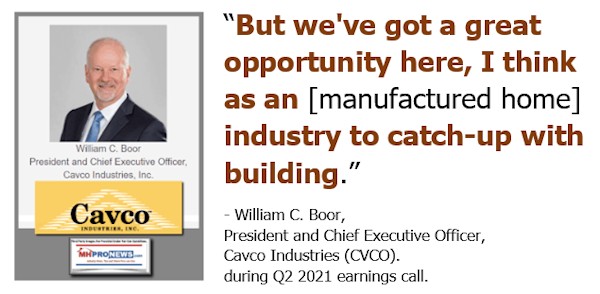
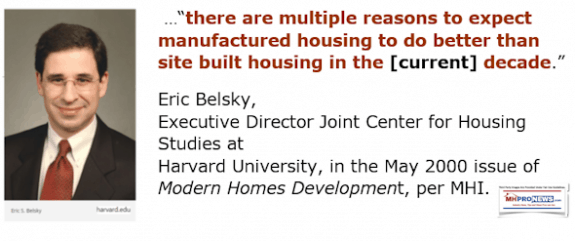
- 10) Among the fresh mainstream news headlines is one that said: “Congress exploring ways to preserve affordable mobile housing supply.” That may get separate treatment in an upcoming report. That noted, the apparent failures of the Big 3 (obviously including Cavco) – which in some ways dominates MHI – to use every possible lever to deal with pressing issues is dumbfounding. For instance.
- 11) Why is there no mention by Boor, others for Cavco, or any of those inquiring on the conference call mention the pending DOE energy rule issue? TMHA, MHARR, and MHI all admit it’s a looming problem that could impact producers significantly. Yet not one question or comment about it? What does that say, imply, or indicate?
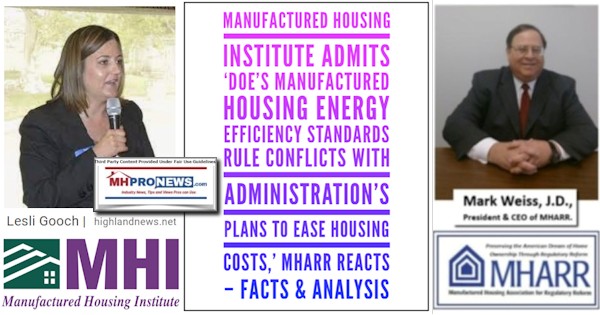
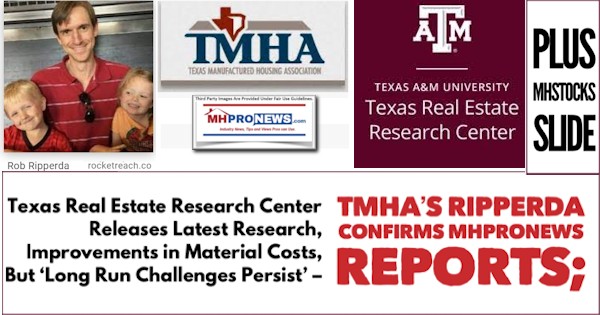

URGENT and IMPORTANT Notice to HUD Code Manufactured Housing Industry Members
DOE Resorts to Deception and Misdirection to Advance Its Flawed Energy Rule for Manufactured Housing
MHARR Files Supreme Court Brief to Reinstate Social Cost of Carbon Injunction
- 12) Other issues could be raised, such as the Duty to Serve, zoning and placement (think Manufactured Housing Improvement Act of 2000 or MHIA), why CrossMods have been a market failure but are still talked about and adorn MHI’s home page as an awkward reminder of just how wrong and ineffective they have been on that and so many other issues.
In other industries and their respective trade media, there are examples of both kiss-tail trade media as well as trade media that is willing to behave like journalists and ask the tougher questions that holds corporate, governmental, and association efforts to accountability. Beyond MHProNews and our ManufacturedHomeLivingNews.com sister site, or MHARR, efforts for accountability are limited to groups such as MHAction and the mainstream media that repeats whatever they say with little or no look behind the scenes.
When there is talk across the left-right divide of a ‘rigged system,’ manufactured housing ought to be an exhibit or special case study. If Cavco were behaving as a truly independent corporation – one that is not an appendage or beholden in some way to Berkshire Hathaway, Blackstone, or some other mega-corporation – then Boor et al would be demanding accountability and action by MHI on the topics noted above. But that is not the case. So, are they inept? Uninformed? Lazy? The answer to each of those inquiries should logically be ‘no.’
The Occam’s Razor conclusion, then, is that Cavco’s leadership is working on some level in collusion with some of their larger peers at MHI. These are apparently satisfied to keep the industry – and thus their own corporation – underperforming during an affordable housing crisis.
Some of the mindless comments by one of the bloggers in our profession that periodically for years has railed against ‘bigger boxes for bigger bucks’ is evidently demolished by Boor. MHProNews and our MHLivingNews sister site has argued from the outset that manufactured housing should go toe-to-toe with conventional builders, and challenge buyers to consider the manufactured home option. If that was done clearly and effectively, then Boor’s remark above could be taken seriously; per Boor: “Beyond taking share in traditional MH markets, we have the added opportunity of increasing shipments into urban areas, a dynamic we have barely scratched the surface of. So, we remain optimistic and I have extreme confidence in this organization’s ability to successfully monitor and adjust to any shift in market dynamics as I’ve seen our people do time and again.” If Boor meant that seriously, the MHIA is how to do it. If he meant that seriously, he would be all in with MHARR in a practical sense is almost alone on the association side pushing the numbered issue herein. But instead, Cavco is toe in the water through acquisitions with MHARR. Instead, they are ‘all in’ with MHI, which is part of the problem and not part of the solution.
The reason that Boor and others at Cavco have gone radio silent with MHProNews is perhaps because they know they can’t directly engage and avoid these obvious questions that are only ‘tough’ because the powers that be want the industry underperforming. Why is there an unstated by apparent desire for underperformance? Because history has revealed that a growing and robust industry can’t easily be consolidated. It is far easier to consolidate an underperforming industry.
The reality of planned underperformance, while posturing something else, is the sub-theme that MHProNews – like Boor’s analogy of a broken record – has to keep hammering away at. Just as Boor finally began to respond to the obvious need to grow organically under regular observations on that count here and our sister site, so too Boor and company may at some point behave like actual corporate leaders, rebel at MHI, form a stronger tie with MHARR, and go all in on creating an authentic national post-production trade group.
More related reports are ahead that will continue to pull back the veil through facts, evidence, and experts analysis that are best found among our so-called rivals here on MHProNews. But don’t doubt that change is coming. Because the broken record, not properly addressed, and exemplified by those dozen bullets in this segment above, are among the reasons that corporate leaders will sooner-or-later have to act in the best interests of their shareholders and stakeholders. Otherwise, they may find themselves on the short end of the stick in probes by public officials, consumer advocates, or professionals who are tired of nonsense and want to see the industry come into its own by the application of good existing laws and proper marketing, sales, and consumer-focused service.
We are just getting warmed up, as the summer heat is coming on. Stay tuned. ##


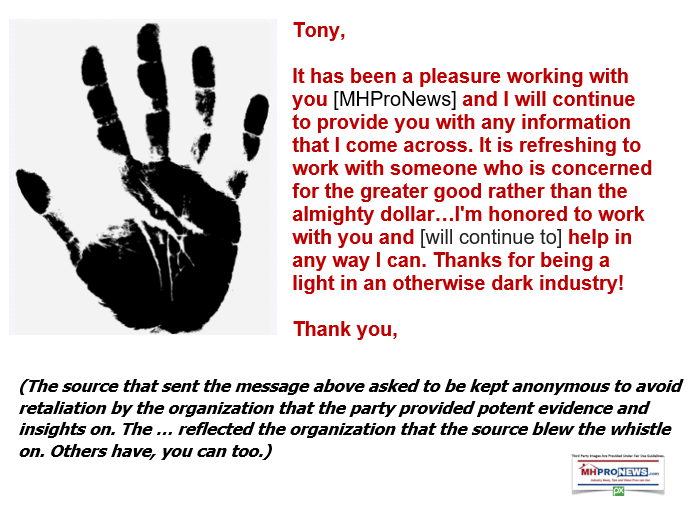
Again, our thanks to you, our sources, and sponsors and God for making and keeping us the runaway number one source for authentic “News through the lens of manufactured homes and factory-built housing” © where “We Provide, You Decide.” © ## (Affordable housing, manufactured homes, reports, fact-checks, analysis, and commentary. Third-party images or content are provided under fair use guidelines for media.) (See Related Reports, further below. Text/image boxes often are hot-linked to other reports that can be access by clicking on them.)

By L.A. “Tony” Kovach – for MHProNews.com.
Tony earned a journalism scholarship and earned numerous awards in history and in manufactured housing.
For example, he earned the prestigious Lottinville Award in history from the University of Oklahoma, where he studied history and business management. He’s a managing member and co-founder of LifeStyle Factory Homes, LLC, the parent company to MHProNews, and MHLivingNews.com.
This article reflects the LLC’s and/or the writer’s position, and may or may not reflect the views of sponsors or supporters.
Connect on LinkedIn: http://www.linkedin.com/in/latonykovach
Related References:
The text/image boxes below are linked to other reports, which can be accessed by clicking on them.
